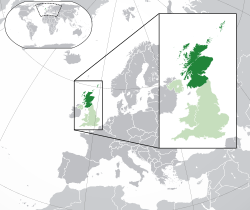So͘-kat-lân
So͘-kat-lân (Eng-gí: Scotland "Óa-im: "su-kot-làn""; So͘-kat-lân Gael-gí: Alba), sī tī Britain-tó pak-pêng ê thó͘-tē, sī cho͘-ha̍p chò Liân-ha̍p Ông-kok 4 ê kok-ka (country) ê 1 ê.
So͘-kat-lân Scotland Alba | |
|---|---|
|
Liân-ha̍p Ông-kok ê kò͘-sêng-kok | |
 | |
| Chú-khoân kok-ka | Liân-ha̍p Ông-kok |
| Hoat-he̍k | So͘-kat-lân |
| Siú-hú | Edinburgh |
| siāng-tōa siâⁿ-chhī | Glasgow |
| Sêng-jīn gí-giân | Eng-gí, So͘-kat-lân-gí, So͘-kat-lân Gael-gí, Eng-kok chhiú-gí |
| Chèng-hú | gī-hōe-chè, kun-chú li̍p-hiàn, khoân-hān úi-jiōng |
• kun-chú | Charles 3-sè |
• siú-siòng | Nicola Sturgeon |
• hù-siú-siòng | John Swinney |
| Li̍p-hoat ki-kò͘ | Gī-hōe |
| Liân-ha̍p Ông-kok Kok-hōe | |
• So͘-kat-lân Tāi-sîn | Alister Jack |
| 59 | |
| Bīn-chek | |
• Lóng-chóng | 77,933 km2 (30,090 sq mi) |
• Chúi-he̍k (%) | 3.00 |
| Jîn-kháu | |
• 2019 nî kó͘-kè |
|
• Bi̍t-tō͘ | 67.5/km2 (174.8/sq mi) |
| GDP (bêng-gī) | 2019 nî kó͘-kè |
• Lóng-chóng | £166 cha̍p-ek |
• Pêng-kin | £30,560 |
| HDI (2019 nî) |
0.925 chin ko · tē 4 miâ |
| Hoè-pè | Eng-pōng (£) (GBP) |
| Sî-khu | UTC (GMT) |
• Joa̍h-thiⁿ (DST) | UTC+1 (BST) |
| Sî-kan keh-sek |
dd/mm/yyyy yyyy-mm-dd (AD) |
| Khui-chhia hong-hiòng | chó |
| Tiān-oē khu-hō | +44 |
| ISO 3166 tāi-hō | GB-SCT |
| Siōng-téng domain | .scot |
Hō-miâ
siu-káiEng-gí-miâ Scotland lâi-goân sī Scoti, sī Latin-gí tùi Gael lâng ê kiò-hoat. Kâng gí-goân ê tē-hō-miâ Scotia, tāi-seng sī kóng kin-á-ji̍t ê Ài-ní-lân. Kàu siōng-bô 11 sè-kí ê sî, Scotia chiah hông ēng lâi piáu-sī ēng Gael-hē giân-gí ê So͘-kat-lân Forth Khe í pak tē-hng; hit-chūn ia̍h ū chi̍t jī tùi Gael-gí Alba piàn--lâi ê Albania kap Albany. Tāi-khài tī Āu-kî Tiong-sè-kí ê sî-chūn, Scots kap Scotland pìⁿ khah phó͘-phiàn ēng lâi hō kin-á-ji̍t ê So͘-kat-lân jîn-bîn kap tē-hng.
Bûn-hiàn tang-tiong, Scotland ê im-e̍k-gí ū So͘-kat-lân[1], So͘-kiat-lân[2], So͘-kek-lân[3] ia̍h Su-kat-lân (Sòaⁿ-thâu-ōe)[4] téng khoán.
Bûn-hoà
siu-káiGiân-gí
siu-káiSo͘-kat-lân ū 3 khoán koan-hong sêng-jīn giân-gí: Eng-gí, So͘-kat-lân-gí, kap So͘-kat-lân Gael-gí.[5][6] So͘-kat-lân Piau-chún Eng-gí (Scottish Standard English) sī So͘-kat-lân só͘ thong-hêng ê chi̍t khoán Eng-gí piàn-chéng.[7] Kun-kù 2011 nî phó͘-cha, 63% ê So͘-kat-lân jîn-kháu sī bē-hiáu So͘-kat-lân-gí--ê.[8] Lēng-gōa tī So͘-kat-lân ia̍h ū chi̍t khoán Koân-tē Eng-gí (Highland English). Nā Gael-gí hong-bīn, chú-iàu sī ùi Se-hng Kûn-tó (Western Isles) teh kóng.[9] Gael-gí ê sú-iōng jîn-kháu, tī 1881 nî ū 250,000 lâng, kàu 2008 nî í-keng chhun 60,000 lâng chó-iū.[10]
Chham-khó
siu-kái- ↑ "Cha̍p-jī goe̍h 27 hō, kū-le̍k 11 goe̍h 12 ji̍t, An I-seng-niû tī So͘-kat-lân kòe-óng". Tâi-lâm Kàu-hōe-pò (264). 1907 nî 3 goe̍h.
- ↑ "Pa Bo̍k-su-niû Ê Sió-toān". Tâi-lâm Kàu-hōe-pò. 1909 nî 10 goe̍h.[íng-íng bô-hāu ê liân-kiat]
- ↑ John Macgowan (1883). "Scotland". English and Chinese dictionary of the Amoy dialect.
- ↑ Siù-chú Iâ-so͘ Ki-tok kâi Sin-ieh Tshuân-tsṳ. 1892.
- ↑ Gaelic Language Plan, www.gov.scot. Retrieved 2 October 2014.
- ↑ Scots Language Policy, www.gov.scot. Retrieved 2 October 2014.
- ↑ Stuart-Smith J. Scottish English: Phonology in Varieties of English: The British Isles, Kortman & Upton (Eds), Mouton de Gruyter, New York 2008. p.47
- ↑ "Scotland's Census 2011". National Records of Scotland. goân-loē-iông tī 2020-07-28 hőng khó͘-pih. 27 May 2014 khòaⁿ--ê.
- ↑ Kenneth MacKinnon. "A Century on the Census—Gaelic in Twentieth Century Focus". University of Glasgow. goân-loē-iông tī 5 September 2007 hőng khó͘-pih. 26 September 2007 khòaⁿ--ê.
- ↑ "Can TV's evolution ignite a Gaelic revolution?". The Scotsman. 16 September 2008.
| Pún bûn-chiuⁿ sī chi̍t phiⁿ phí-á-kiáⁿ. Lí thang tàu khok-chhiong lâi pang-chō͘ Wikipedia. |

